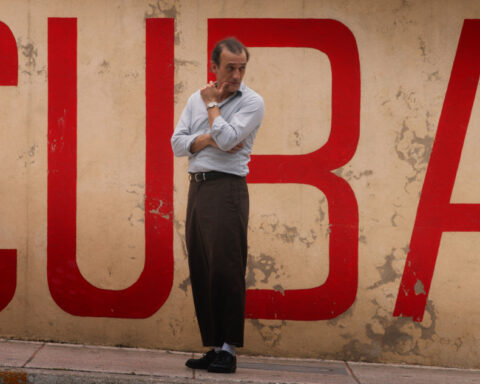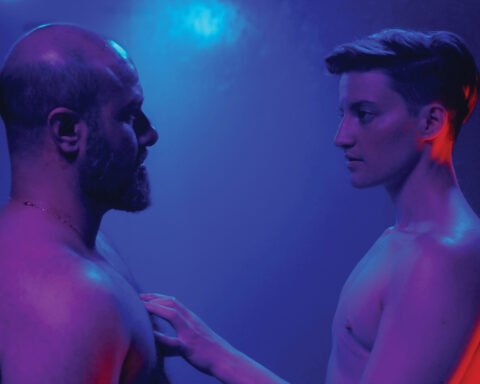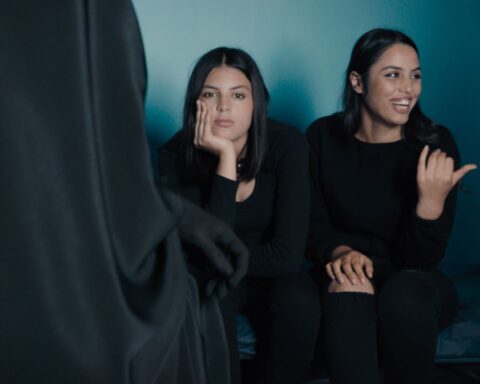documentary (noun): A movie or a television or radio program that provides a factual record or report — Oxford Dictionaries (online)
documentary (noun): A movie or television program that tells the facts about actual people and events — Merriam-Webster
An increasing number of nonfiction filmmakers in recent years have abandoned the confines of documentary as a branch of journalism or filmed historic artifact to explore more adventurous modes of storytelling.
Recognizing this burgeoning trend, New York’s Film Society of Lincoln Center (FSLC) launched Art of the Real this past spring. It’s an ambitious annual film series devoted to freeing documentary from all narrative, structural and conceptual restrictions; a platform to showcase nonfiction film as an expansive, rebellious and evolving category as well as a complex, challenging and divisive art form.
Held at the deluxe new Elinor Bunin Munroe Film Center, the series joins an already impressive calendar of annual FSLC events that includes New Directors/New Films, Rendez-Vous with French Cinema, Dance on Camera, Human Rights Watch and The New York Film Festival.
Curated by FSLC’s director of programming Dennis Lim, along with programmer-at-large Rachael Rakes, the first edition of Art of the Real featured a carefully chosen sampling of 35 old and new titles, post-screening discussions with many of the filmmakers and introductions by other special guests.
The programme surveyed a dazzling array of nonfiction narrative and aesthetic imperatives including autobiography, agitprop, essay, travel diary, fictional hybrid and gallery installation. Several of the films resisted any classification. Most of the contemporary selections had previously been shown at other festivals, while some of the vintage titles like Alberto Grifi and Massimo Sarchielli’s Anna (Italy, 1972-75) and Thom Andersen’s Eadweard Muybridge, Zoopraxographer (U.S., 1975) are rarely screened.
“We wanted to expand our idea of documentary cinema,” Lim explained. “So it was not about applying criteria, but expanding the criteria that typically applied to these kinds of showcases. We wanted to include films that dealt with the real in some way, whether they were straight-ahead, complete documentaries or whether they were more hybrid films or even fiction films that had some relationship with the real. Also, we wanted to move the emphasis away from documentary as information, as journalism, and to really think about it as an art form—an art form with a very long history, an art that really is closely connected to some of the most radical and important developments in the history of cinema.”
In film’s early days, nonfiction was a playground for experimentation. Even Robert Flaherty, the so-called father of feature-length documentary, famously took generous liberties, mixing facts with fiction to create dramas for the camera. Yet in the decades since Nanook of the North (and especially since the advent of television), documentary has come to represent a more predictable art form—a category in which the viewer may anticipate “real facts” and “real stories.”
All of the films presented in Art of the Real were technically nonfiction. But where reality/documentary ended and fictional narrative began seemed deliberately yet enchantingly inconclusive, producing a fascinating hybrid.
“I think the point of hybridity is that it resides between two poles; it exists on a spectrum,” Lim said. “There are so many ways to define hybrid. On the one end, you might have something that you could consider pure fiction or close to pure fiction and then on the other, complete documentary. But the moment you turn on a camera, there is an element of decision-making that goes into it, so there is always some aspect of manipulation. It’s not as clear-cut as documentary on one side and fiction on the other.”
The reality is that all nonfiction films are complicated by opinion and point of view. Once you are an observer (even of your own life), a natural bias or preference takes over. So in pursuit of “truth,” one inevitably encounters fictions. Also a typical documentary tends to be structured to reveal a recognizable narrative and dramatic arc, whether or not one actually existed. Yet the story is presented as having been “real.”
Philipp Hartmann’s Time Goes By Like A Roaring Lion (Germany, 2013), Nicolas Provost’s Plot Point Trilogy (Belgium, 2012), Benjamin Pearson’s Former Models (U.S., 2013) and Robert Greene’s Actress (U.S., 2014) were among the films shown that messed with these notions in especially artful ways. Each challenged the viewer to consider reality or truth as a function of imagination.
Some of the other recent films screened were: Tan Pin Pin’s To Singapore, With Love (Singapore, 2013), which answers the question ‘What happens when you leave?’ in a tender portrait of elderly political exiles who may never return home; The Second Game (Romania, 2014) by Corneliu Porumbolu, which uses a deceptively static premise, a conversation between father and son recorded while reviewing a video of a Soviet-era soccer match to expose some chilling beliefs; Harun Farocki’s A New Product (Germany, 2012), a sublimely subversive satire about managerial tactics, corporate culture and industrial design; and Bloody Beans (Algeria/France, 2013), Narimane Mari’s surrealist reenactment of the Algerian War of Independence, loosely staged by a group of young children on and around a beach in Algiers. The film concludes with the ensemble floating in the water, reciting a poem by radical French playwright Antonin Artaud that asks: “Is it Better to Be, Than to Obey?”
“In nonfiction writing we have so many ways to be creative; different classifications for essays and memoirs, which we don’t have so much for cinema,” Lim continued. “One thing we wanted to do was actually acknowledge that a wide variety of films do in fact exist. They have made an impression. But in some cases they have been sidelined or forgotten, partly because of the popularity and the undeniable usefulness of documentary as an informational conduit, as an activist tool, as a way of educating people. All of which are very valid, but I think those things, especially in the last few years, have overshadowed the other ways in which nonfiction cinema can be used, can be manipulated, can be meaningful to people.”
In just eight years, Harvard University’s Sensory Ethnography Lab (SEL) has earned a reputation for producing especially meaningful nonfiction cinema: rich, immersive films that are meant to be experienced rather than simply viewed. SEL received a short retrospective during the first week of the 17-day series. Included was Stephanie Spray’s and Pacho Valez’ entrancing Manakamana (U.S., 2013), which went on to a successful two-month theatrical run at New York’s IFC Center. Titles that inspired SEL filmmakers were also screened: Jean Rouch’s Jaguar (France, 1954/1967), Robert Gardner’s Forest of Bliss (U.S./India, 1986) and Jana Sevcikova’s Jakub (Czech Republic, 1992).
“We first thought of this series as a showcase for new films that might fall between the cracks because they’re not easily defined, because they are somewhat documentary, somewhat experimental,” Lim explained. “Then very quickly the conversation evolved to ‘How do we put these films into a meaningful context?’
“That’s when we decided we would show older films as well, to enlarge the conversation around the selection of new work. That was fun and made it a bit different than a typical documentary festival. We didn’t really need to have premieres. We just wanted to put together work both new and old that was all strong, would all stand alone, but when you put it together there was actually something more.”
Lim and Rakes included landmark genre-busting films by directors such as Derek Jarman, Raymond Depardon and Paulo Rocha, as well as work by two of nonfiction’s most ingenious outliers, James Benning and Thom Andersen, who were present at their screenings. Depardon’s San Clemente (Italy, 1982) was especially riveting, a poignant, droll yet relevant study of a psychiatric hospital in Venice on the brink of closure. The camera seemed to depict the POV of an occupant silently observing, following or giving chase to doctors, patients and visitors alike. It was direct cinema played as brutally honest and heartbreaking black comedy.
“Some of the things I was most excited about were the older screenings,” Lim admitted. “At the screening of Anna, more than 100 people came to see a 40-year-old Italian documentary shot on rather primitive video, but also a film I think is incredibly important in the history of documentary. For me, that was one of the highlights of the series. Also to have Rachel Kushner [introduce the film], who has written a book The Flamethrowers, a very carefully, brilliantly researched novel that is very much informed by history, by art and by cinema…it was really great to have [her] put it in context as well.”
Grifi and Sarchielli’s 225-minute Anna begins as a curiosity; a crudely shot black-and-white video time capsule of hippie-era Rome with a radiantly attractive, pregnant teenager as its primary focus. About two hours in, it gets really intriguing, as the balance of power shifts from creepy filmmaker to increasingly manipulative subject. The question of who is using who is never quite resolved, yet it’s implied all sorts of moral and ethical lines may have been crossed. Anna is still risky and unnerving, a queasy precursor of reality TV. It was by far the most polemic film screened in the series.
Sadly (and possibly sacrilege to say so), Jarman’s Blue seemed dated, overwhelmed by its melodramatic early-’90s soundtrack—though it did serve to remind one of the demise of 35mm film. The screen’s once intense blue colour field, its saturation weakened by time, the print pitted and scratched by years of projection: Blue now represents not only Jarman’s swan song, but that of film itself.











